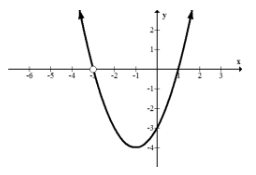2.8 Ceros de funciones racionales
- Page ID
- 107378
\( \newcommand{\vecs}[1]{\overset { \scriptstyle \rightharpoonup} {\mathbf{#1}} } \)
\( \newcommand{\vecd}[1]{\overset{-\!-\!\rightharpoonup}{\vphantom{a}\smash {#1}}} \)
\( \newcommand{\dsum}{\displaystyle\sum\limits} \)
\( \newcommand{\dint}{\displaystyle\int\limits} \)
\( \newcommand{\dlim}{\displaystyle\lim\limits} \)
\( \newcommand{\id}{\mathrm{id}}\) \( \newcommand{\Span}{\mathrm{span}}\)
( \newcommand{\kernel}{\mathrm{null}\,}\) \( \newcommand{\range}{\mathrm{range}\,}\)
\( \newcommand{\RealPart}{\mathrm{Re}}\) \( \newcommand{\ImaginaryPart}{\mathrm{Im}}\)
\( \newcommand{\Argument}{\mathrm{Arg}}\) \( \newcommand{\norm}[1]{\| #1 \|}\)
\( \newcommand{\inner}[2]{\langle #1, #2 \rangle}\)
\( \newcommand{\Span}{\mathrm{span}}\)
\( \newcommand{\id}{\mathrm{id}}\)
\( \newcommand{\Span}{\mathrm{span}}\)
\( \newcommand{\kernel}{\mathrm{null}\,}\)
\( \newcommand{\range}{\mathrm{range}\,}\)
\( \newcommand{\RealPart}{\mathrm{Re}}\)
\( \newcommand{\ImaginaryPart}{\mathrm{Im}}\)
\( \newcommand{\Argument}{\mathrm{Arg}}\)
\( \newcommand{\norm}[1]{\| #1 \|}\)
\( \newcommand{\inner}[2]{\langle #1, #2 \rangle}\)
\( \newcommand{\Span}{\mathrm{span}}\) \( \newcommand{\AA}{\unicode[.8,0]{x212B}}\)
\( \newcommand{\vectorA}[1]{\vec{#1}} % arrow\)
\( \newcommand{\vectorAt}[1]{\vec{\text{#1}}} % arrow\)
\( \newcommand{\vectorB}[1]{\overset { \scriptstyle \rightharpoonup} {\mathbf{#1}} } \)
\( \newcommand{\vectorC}[1]{\textbf{#1}} \)
\( \newcommand{\vectorD}[1]{\overrightarrow{#1}} \)
\( \newcommand{\vectorDt}[1]{\overrightarrow{\text{#1}}} \)
\( \newcommand{\vectE}[1]{\overset{-\!-\!\rightharpoonup}{\vphantom{a}\smash{\mathbf {#1}}}} \)
\( \newcommand{\vecs}[1]{\overset { \scriptstyle \rightharpoonup} {\mathbf{#1}} } \)
\( \newcommand{\vecd}[1]{\overset{-\!-\!\rightharpoonup}{\vphantom{a}\smash {#1}}} \)
\(\newcommand{\avec}{\mathbf a}\) \(\newcommand{\bvec}{\mathbf b}\) \(\newcommand{\cvec}{\mathbf c}\) \(\newcommand{\dvec}{\mathbf d}\) \(\newcommand{\dtil}{\widetilde{\mathbf d}}\) \(\newcommand{\evec}{\mathbf e}\) \(\newcommand{\fvec}{\mathbf f}\) \(\newcommand{\nvec}{\mathbf n}\) \(\newcommand{\pvec}{\mathbf p}\) \(\newcommand{\qvec}{\mathbf q}\) \(\newcommand{\svec}{\mathbf s}\) \(\newcommand{\tvec}{\mathbf t}\) \(\newcommand{\uvec}{\mathbf u}\) \(\newcommand{\vvec}{\mathbf v}\) \(\newcommand{\wvec}{\mathbf w}\) \(\newcommand{\xvec}{\mathbf x}\) \(\newcommand{\yvec}{\mathbf y}\) \(\newcommand{\zvec}{\mathbf z}\) \(\newcommand{\rvec}{\mathbf r}\) \(\newcommand{\mvec}{\mathbf m}\) \(\newcommand{\zerovec}{\mathbf 0}\) \(\newcommand{\onevec}{\mathbf 1}\) \(\newcommand{\real}{\mathbb R}\) \(\newcommand{\twovec}[2]{\left[\begin{array}{r}#1 \\ #2 \end{array}\right]}\) \(\newcommand{\ctwovec}[2]{\left[\begin{array}{c}#1 \\ #2 \end{array}\right]}\) \(\newcommand{\threevec}[3]{\left[\begin{array}{r}#1 \\ #2 \\ #3 \end{array}\right]}\) \(\newcommand{\cthreevec}[3]{\left[\begin{array}{c}#1 \\ #2 \\ #3 \end{array}\right]}\) \(\newcommand{\fourvec}[4]{\left[\begin{array}{r}#1 \\ #2 \\ #3 \\ #4 \end{array}\right]}\) \(\newcommand{\cfourvec}[4]{\left[\begin{array}{c}#1 \\ #2 \\ #3 \\ #4 \end{array}\right]}\) \(\newcommand{\fivevec}[5]{\left[\begin{array}{r}#1 \\ #2 \\ #3 \\ #4 \\ #5 \\ \end{array}\right]}\) \(\newcommand{\cfivevec}[5]{\left[\begin{array}{c}#1 \\ #2 \\ #3 \\ #4 \\ #5 \\ \end{array}\right]}\) \(\newcommand{\mattwo}[4]{\left[\begin{array}{rr}#1 \amp #2 \\ #3 \amp #4 \\ \end{array}\right]}\) \(\newcommand{\laspan}[1]{\text{Span}\{#1\}}\) \(\newcommand{\bcal}{\cal B}\) \(\newcommand{\ccal}{\cal C}\) \(\newcommand{\scal}{\cal S}\) \(\newcommand{\wcal}{\cal W}\) \(\newcommand{\ecal}{\cal E}\) \(\newcommand{\coords}[2]{\left\{#1\right\}_{#2}}\) \(\newcommand{\gray}[1]{\color{gray}{#1}}\) \(\newcommand{\lgray}[1]{\color{lightgray}{#1}}\) \(\newcommand{\rank}{\operatorname{rank}}\) \(\newcommand{\row}{\text{Row}}\) \(\newcommand{\col}{\text{Col}}\) \(\renewcommand{\row}{\text{Row}}\) \(\newcommand{\nul}{\text{Nul}}\) \(\newcommand{\var}{\text{Var}}\) \(\newcommand{\corr}{\text{corr}}\) \(\newcommand{\len}[1]{\left|#1\right|}\) \(\newcommand{\bbar}{\overline{\bvec}}\) \(\newcommand{\bhat}{\widehat{\bvec}}\) \(\newcommand{\bperp}{\bvec^\perp}\) \(\newcommand{\xhat}{\widehat{\xvec}}\) \(\newcommand{\vhat}{\widehat{\vvec}}\) \(\newcommand{\uhat}{\widehat{\uvec}}\) \(\newcommand{\what}{\widehat{\wvec}}\) \(\newcommand{\Sighat}{\widehat{\Sigma}}\) \(\newcommand{\lt}{<}\) \(\newcommand{\gt}{>}\) \(\newcommand{\amp}{&}\) \(\definecolor{fillinmathshade}{gray}{0.9}\)Los ceros de una función son la colección de\(x\) valores donde la altura de la función es cero. ¿Cómo encuentras estos valores para una función racional y qué pasa si el cero resulta ser un agujero?
Encontrar ceros de funciones racionales
Los ceros también se conocen como\(x\) -intercepciones, soluciones o raíces de funciones. Son los\(x\) valores donde la altura de la función es cero. Para las funciones racionales, es necesario establecer el numerador de la función igual a cero y resolver los\(x\) valores posibles. Si se produce un agujero en el\(x\) valor, entonces no se considera un cero porque la función no está realmente definida en ese punto.
Tome la siguiente función racional:
\(f(x)=\frac{(x-1)(x+3)(x+3)}{x+3}\)
Observe cómo uno de los\(x+3\) factores parece cancelar e indicar una discontinuidad removible. A pesar de que hay dos\(x+3\) factores, el único cero ocurre en\(x=1\) y el agujero ocurre en (-3,0).

Mire el video a continuación y concéntrese en la parte de este video que discute\(x\) agujeros e intercepciones.
Ejemplos
Anteriormente, se le preguntó cómo encontrar los ceros de una función racional y qué sucede si el cero es un agujero. Para encontrar los ceros de una función racional, establezca el numerador igual a cero y resuelva para los\(x\) valores. Cuando un hoyo y un cero ocurren en el mismo punto, el hoyo gana y no hay cero en ese punto.
Cree una función con ceros en\(x=1,2,3\) y agujeros en\(x=0,4\).
Hay un número infinito de funciones posibles que se ajustan a esta descripción porque la función se puede multiplicar por cualquier constante. Una posible función podría ser:
\(f(x)=\frac{(x-1)(x-2)(x-3) x(x-4)}{x(x-4)}\)
Tenga en cuenta que 0 y 4 son agujeros porque cancelan.
Identificar los ceros, agujeros e\(y\) intercepciones de la siguiente función racional sin graficar.
\(f(x)=\frac{x(x-2)(x-1)(x+1)(x+1)(x+2)}{(x-1)(x+1)}\)
Los agujeros ocurren en\(x=-1,1\). Para obtener los puntos exactos, estos valores deben ser sustituidos en la función con los factores cancelados.
\(\begin{aligned} f(x) &=x(x-2)(x+1)(x+2) \\ f(-1) &=0, f(1)=-6 \end{aligned}\)
Los agujeros son (-1,0)\(;(1,6)\). Los ceros ocurren en\(x=0,2,-2\). El cero que se supone que ocurre en ya se\(x=-1\) ha demostrado que es un agujero en su lugar.
Identificar las intercepciones y, agujeros y ceros de la siguiente función racional.
\(f(x)=\frac{6 x^{3}-7 x^{2}-x+2}{x-1}\)
Después de notar que se produce un posible agujero en\(x=1\) y usando la división polinómica larga en el numerador, debe obtener:
\(f(x)=\left(6 x^{2}-x-2\right) \cdot \frac{x-1}{x-1}\)
Se produce un agujero en el\(x=1\) que resulta ser el punto (1,3) porque\(6 \cdot 1^{2}-1-2=3\).
La\(y\) -intercepción siempre ocurre donde\(x=0\) que resulta ser el punto (0, -2) porque\(f(0)=-2\)
Para encontrar los\(x\) -intercepts es necesario factorial la parte restante de la función:
\((2 x+1)(3 x-2)\)
Así los ceros\(\left(x\right.\) -intercepciones) son\(x=-\frac{1}{2}, \frac{2}{3}\).
Identificar los ceros y agujeros de la siguiente función racional.
\(f(x)=\frac{2(x+1)(x+1)(x+1)}{2(x+1)}\)
El agujero ocurre en\(x=-1\) el que resulta ser un doble cero. El hoyo sigue ganando así que el punto (-1,0) es un hoyo. No hay ceros. La constante 2 delante del numerador y el denominador sirve para ilustrar el hecho de que los escalares constantes no impactan en los\(x\) valores ni de los ceros ni de los agujeros de una función.
Revisar
Identificar las intercepciones y agujeros de cada una de las siguientes funciones racionales.
1. \(f(x)=\frac{x^{3}+x^{2}-10 x+8}{x-2}\)
2. \(g(x)=\frac{6 x^{3}-17 x^{2}-5 x+6}{x-3}\)
3. \(h(x)=\frac{(x+2)(1-x)}{x-1}\)
4. \(j(x)=\frac{(x-4)(x+2)(x+2)}{x+2}\)
5. \(k(x)=\frac{x(x-3)(x-4)(x+4)(x+4)(x+2)}{(x-3)(x+4)}\)
6. \(f(x)=\frac{x(x+1)(x+1)(x-1)}{(x-1)(x+1)}\)
7. \(g(x)=\frac{x^{3}-x^{2}-x+1}{x^{2}-1}\)
8. \(h(x)=\frac{4-x^{2}}{x-2}\)
9. Cree una función con agujeros en\(x=3,5,9\) y ceros en\(x=1,2\).
10. Cree una función con agujeros en\(x=-1,4\) y ceros en\(x=1\).
11. Cree una función con agujeros en\(x=0,5\) y ceros en\(x=2,3\).
12. Cree una función con agujeros en\(x=-3,5\) y ceros en\(x=4\).
13. Cree una función con agujeros en\(x=-2,6\) y ceros en\(x=0,3\).
14. Cree una función con agujeros en\(x=1,5\) y ceros en\(x=0,6\).
15. Cree una función con agujeros en\(x=2,7\) y ceros en\(x=3\).

